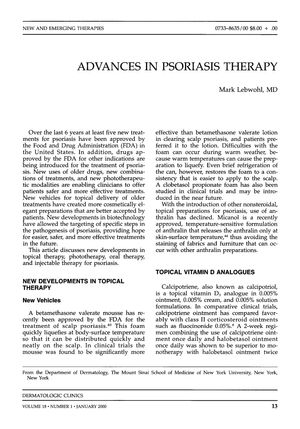Advances in Psoriasis Therapy
January 2000
in “
Dermatologic Clinics
”
betamethasone valerate anthralin calcipotriene vitamin D3 analogue corticosteroids retinoid dermatitis tazarotene vitamin D analogues topical methotrexate macrolide antibiotics narrowband UV-B photodynamic therapy acitretin cyclosporine mycophenolate mofetil 6-thioguanine T-cell activation betamethasone Dovonex vitamin D steroids retinoids methotrexate antibiotics UV-B therapy PDT Soriatane Neoral CellCept thioguanine

TLDR New psoriasis treatments are effective but come with side effects and risks.
The document from 2000 reports on the progress in psoriasis treatments over the previous six years, highlighting the approval of five new treatments by the FDA and the use of drugs initially approved for other conditions. It mentions new topical therapies such as a betamethasone valerate mousse and a temperature-sensitive anthralin formulation, as well as the effectiveness of calcipotriene, a vitamin D3 analogue, particularly when used with corticosteroids. However, it also notes the potential for irritation and rare hypercalcemia with calcipotriene, and retinoid dermatitis with the topical retinoid tazarotene. The document discusses the exploration of new vitamin D analogues, topical methotrexate, and macrolide antibiotics, along with emerging phototherapies like narrowband UV-B and photodynamic therapy. Oral therapies mentioned include acitretin and cyclosporine, with the latter having side effects such as hypertension and nephrotoxicity. Other oral treatments like mycophenolate mofetil and 6-thioguanine are effective but carry risks of severe side effects. Injectable therapies targeting T-cell activation are also showing promise. The document concludes that while these treatments are effective, they are accompanied by various side effects and risks.




